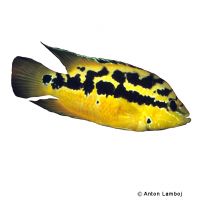Tricolour Cichlid (Trichromis salvini)
| Tricolour Cichlid Trichromis salvini | |
|---|---|
| Name | Tricolour Cichlid |
| Name Lat. | Trichromis salvini |
| Synonym | Cichlasoma salvini |
| Family | Cichlids |
| Family lat. | Cichlidae |
| Order | Cichlids |
| Order lat. | Cichliformes |
| Origin | Central America |
| Habitat | Rivers |
| Diet | Omnivore |
| pH | 6.5-8.0 |
| Behavior | Aggressive |
| Keeping | Pair |
| Care Level | Moderate |
| Reproduction | Substrate spawner |
| Breeding | Moderately difficult |
| Life Span | 6-10 years |
| Protection | No |
| Metric Units | |
| Size | 15 cm |
| Temperature | 22-28 °C |
| Hardness | 5-25 °dH |
| Aquarium | ~ 300 l |
| US Units | |
| Size | 6" |
| Temperature | 72-82 °F |
| Hardness | 89-445 ppm |
| Aquarium | ~ 80 gal |
Distribution and habitat
The distribution area of the Salvins cichlids is southern Mexico, Guatemala, Honduras and Belize, in rivers flowing to the Atlantic Ocean in Central America. They live in the riparian areas of rivers, where they find numerous shelter and hiding places, such as roots, branches and dead wood. For hunting, they often stay in the flowing middle of the river
Maintenance
They need a well structured aquarium with a robust border planting, with numerous hiding places (stones, roots) and a lot of swimming space. A dark, sandy substrate covered with some foliage and slightly dim light (floating plants) is ideal.
No ammonia, ammonium and nitrite should be detectable, the nitrate value should not exceed 100 mg/l. To ensure the water quality and oxygen content, a filter and heater adapted to the aquarium size is required, as well as lighting for the species-appropriate day-night rhythm of the animals.
Diet
In the wild they feed on insect larvae, small crustaceans and small fish. The food supply consists of live, frozen and dry food. For a balanced diet, feed once a day with a high-quality, protein-rich dry food for cichlids (flakes, granules, pellets) as well as daphnia, artemia, mysis, mosquito larvae, etc. (live or frozen).
It is recommended to feed small portions several times a day. Only feed as much as will be eaten within a few minutes. A regular and varied diet promotes health and increases resistance.
Behaviour and compatibility
It is recommended to keep them in pairs. They are very aggressive and behave very territorial not only at spawning time. Keeping several animals is only possible in a larger and richly structured tank. They should only be socialized with larger and robust fish. Too small fish are considered as prey.
Basically, only compatible fish species with similar demands on water quality and water temperature should be socialized.
Sex dimorphism
Males are more strongly colored and have longer, more pointed dorsal and anal fins. The females have a spot in the dorsal fin and a dark spot on the lower edge of the gill cover
Reproduction and breeding
They spawn on shallow stones or roots (open brooders). Both parents perform brood care and defend the territory (parental family). After about 2 days the fry hatch, which are then usually housed in a bottom pit until they swim freely after 5-7 days. Often the fry are still guarded by the parents for some time and are led to the feeding places in the aquarium.
Fry must be fed several times a day with special rearing food (Artemia nauplii). In community tanks breeding is hardly possible, because the young fish are easy prey.
Important
There are populations that differ in coloration (site variants)
They hardly burrow and do not damage plants.
The well-being of the fish should be checked regularly. Temperature should be checked daily, pH, hardness and nitrate levels at least every 14 days. Regular partial water changes are recommended, even if the pollutant level has not yet reached the upper limit. Sudden changes in water quality should be avoided. Newly introduced fish must be accustomed slowly to the water in the aquarium.
Further literature can be found in your pet store.
References
Text: Werner Winter; Image: Anton Lamboj
Source: BMEL (1998): Tierschutzgutachten - Haltung von Zierfischen (Süßwasser); RIEHL & BAENSCH (2006): Aquarien Atlas Bd. 1, Mergus Verlag; ENGELMANN (2005): Zootierhaltung - Tiere in menschlicher Obhut: Fische, Verlag Harri Deutsch
- Gemäß § 21 Abs. 5 Tierschutzgesetz idgF
